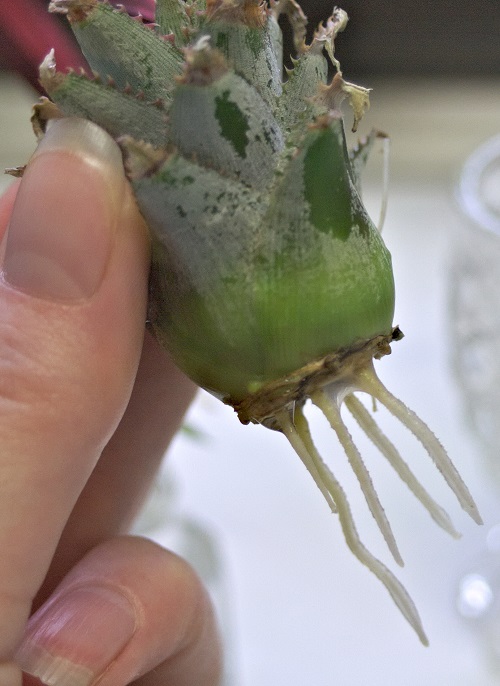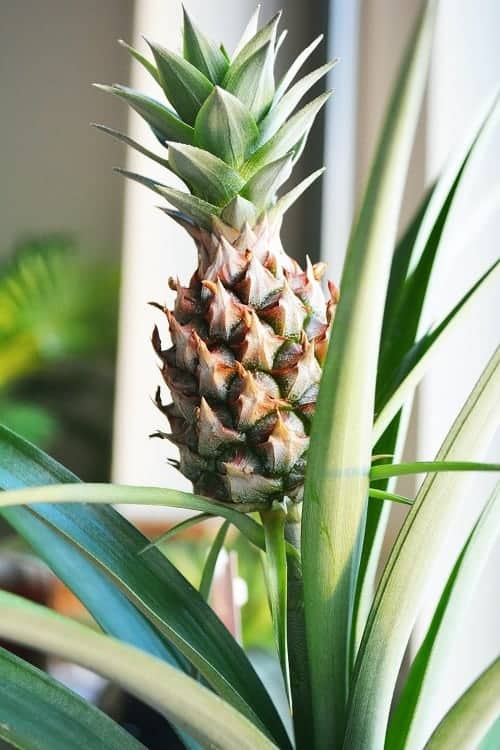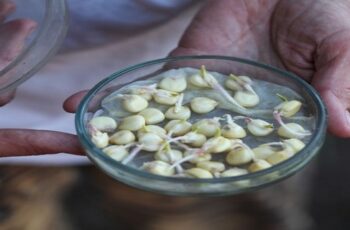Ad Blocker Detected
Our website is made possible by displaying online advertisements to our visitors. Please consider supporting us by disabling your ad blocker.
I thoroughly enjoy the process of propagating food scraps. It’s a delightful experience where I not only get to savor delicious meals but also obtain a new plant, all while being environmentally conscious!
Among the foods I love to transform into plants, pineapples are a definite favorite. Growing a pineapple from its top is surprisingly straightforward, provided you follow the right procedures to avoid rot and promote root growth.
Continue reading for a comprehensive guide on planting a pineapple top and nurturing your very own pineapple bush!
Growing A Pineapple Top Step 1: Choose Your Pineapple
Not all pineapples are equally suited for propagation. When picking out a pineapple, opt for one with vibrant green leaves and signs of healthy new growth. A few wilted or brown-tipped leaves are acceptable, but the core should be robust and the leaves firmly attached.
It’s worth noting that often, the choicest pineapple crowns are found on fruits that may not be at their peak for consumption. As the fruit ripens and yellows, the crown has more time to deteriorate. Finding a balance is key, as we do want to enjoy our pineapple. If it doesn’t turn out as sweet as expected, it can always be turned into a delicious smoothie.
Additionally, it’s crucial to inspect the chosen pineapple top for any signs of pests. On occasion, I’ve come across scale or mealybugs, and this is not the healthy beginning I want for my new pineapple plant.
Tip: I opted for a mini pineapple for my propagation project. While they may not always be readily available in every store, I appreciated that they tend to have more robust crowns compared to the larger ones.
Growing A Pineapple Top Step 2: Preparing The Crown
Once you have your pineapple, the next step is to separate the part you intend to grow from the part you plan to consume.
For this, it’s best to twist off the leafy crown rather than using a knife. If the leaves are prickly, as they were in my case, wearing garden gloves can be helpful. Gently twist until the top comes free, being careful not to damage too many leaves in the process.
Once you have the pineapple crown, ensure there’s no residual fruit attached to it. Then, remove a few of the lower leaves to expose the stalk. This promotes freer root growth and helps prevent rot.
Allow the pineapple crown to air dry for a few days. This additional step is crucial in preventing potential rot.
Tip: If you examine the underside of the pineapple top, you’ll notice small circular formations. These are the nodes from which roots will eventually sprout. They are what we’re aiming for in the propagation process.

Growing A Pineapple Top Step 3: Propagation
Growing a pineapple from the top can be achieved through either water propagation or soil propagation, depending on your preference. Personally, I appreciate the aesthetic of cuttings in elegant glass containers, so I lean towards propagating in water.
How To Root Pineapple In Water
Following the preparation of the crown, the simplest propagation method is to place it in a glass of water. Situate the container in a well-lit, warm area and let it be, except for changing the water approximately once a week.
Results may or may not show within about 2-5 weeks. One of the benefits of growing a pineapple top in water is that you can witness the growth happening in real time!
A successful propagation will exhibit the appearance of roots with no signs of rot or fungus. It’s worth noting that not all attempts at regrowth yield positive outcomes—some pineapple crowns may not thrive. Be prepared to try multiple pineapples before achieving success in growing your own pineapple plant.
Once you’re satisfied with the root development of your newly grown pineapple plant, it’s time to move on to the planting phase.

How To Root Pineapple In Soil
You have the option to either plant your pineapple top directly in soil or let it establish roots in water before potting it. Whichever method you opt for, when it’s time to pot the plant, select a container of suitable size with a drainage hole. Utilize well-draining soil, incorporating some gritty materials like bark or perlite to improve drainage. Cactus soil works well.
Initially, position the plant in a spot with bright yet indirect light. Gradually introduce it to full sun, allowing it to acclimate. Pineapple plants thrive with abundant light, similar to succulents or cacti. Provide them with as much light as possible.
Tip: If you planted directly in soil, it may be a bit tricky to determine if your propagation attempt was successful. To check for root growth, give the plant a very gentle tug. If you encounter resistance, it indicates success! Another positive sign is the emergence of new growth, confirming that the process has been successful.

Growing A Pineapple Plant Step 4: Pineapple Plant Care
Congratulations! You are now the proud owner of a brand-new pineapple plant. So, what’s next?
Caring for a pineapple plant isn’t too complex. Remember, these are tropical plants that thrive on ample light and moisture. Place yours in the sunniest spot available. Water it regularly enough to maintain lightly moist soil (avoiding excessive wetness or sogginess). As mentioned earlier, using a well-draining soil type is crucial to prevent root rot.
Humidity plays a vital role in a pineapple plant’s well-being. If your home tends to be dry, consider placing your pineapple in a more humid area like the bathroom. Alternatively, you can increase humidity by using a pebble tray, grouping plants together to create a mini rainforest, or running a humidifier.
During the warm summer months (or year-round in warmer climates), your pineapple plant will thrive outdoors. Just be sure to bring it back inside well before the first frost. Throughout the growing season, you can apply a light houseplant fertilizer about once a week or so.


